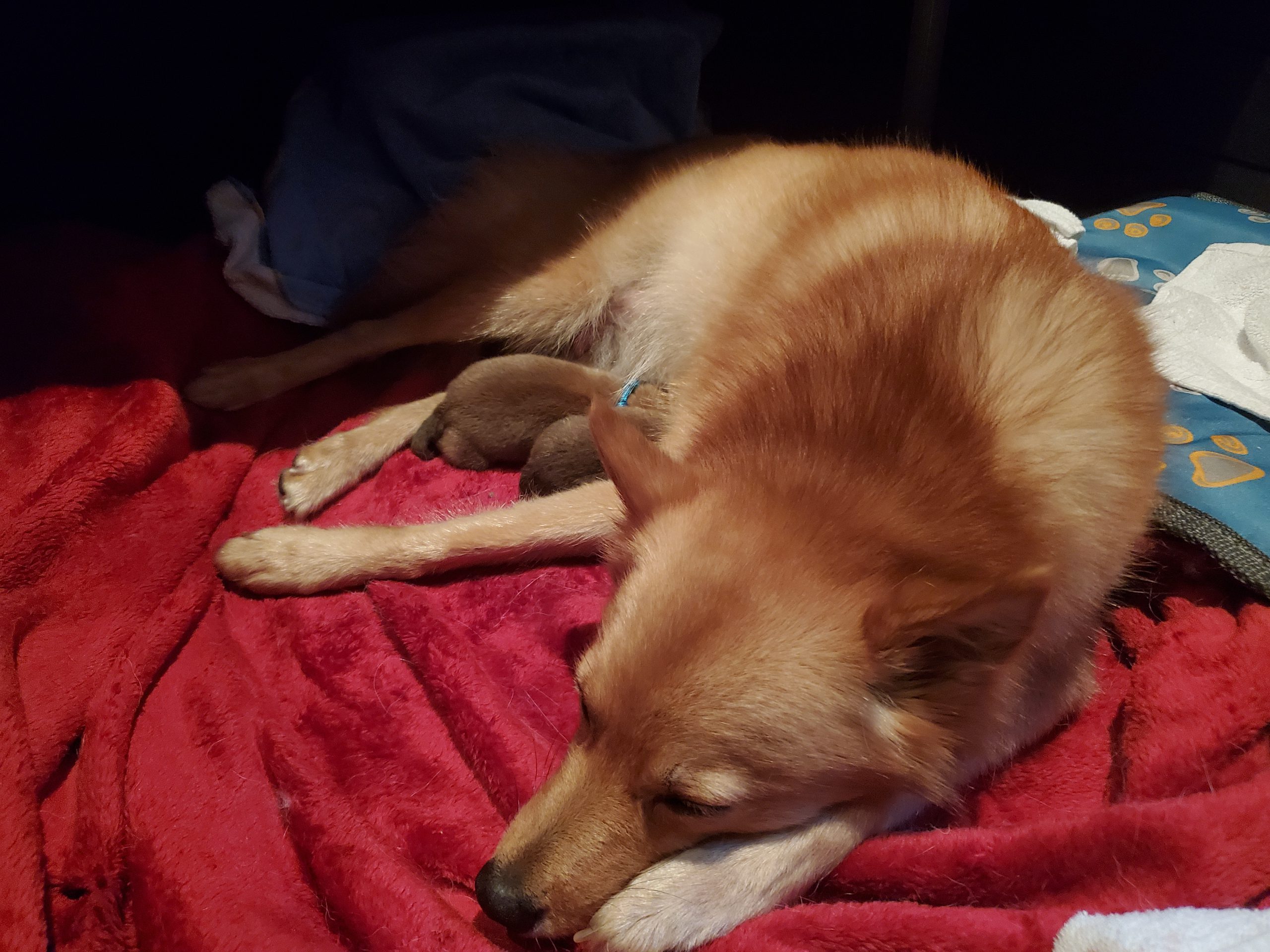The Whelping Pause, a naturally occuring event
Dog breeders and vets alike have gotten into the habit of identifying an event that is completely normal and natural during the whelping process for many bitches as “uterine inertia”. The bitch has delivered one or more puppies and then she has stopped contracting. She is no longer in labor. She is in a “Whelping Pause”, a completely naturally occurring event.
This has been viewed as an emergency that requires the use of oxytocin and when that doesn’t work (and it doesn’t) it is followed by a c-section. This has been happening for so many years that it is a near insurmountable task to re-educate the dog breeder and change this practice. During my seminars in the last year or so I’ve been asking for a show of hands of how many breeders have experienced this event; a cessation of contractions in an otherwise free whelp and I’ve been keeping statistics.
I see hundreds of dog breeders a year and here is what I have found: 60-75% of all dog breeders have experienced the whelping pause. Most of them have gone in for c-sections and some of them have lost their bitches. Many of them have lost puppies. The rest of them simply didn’t know that their bitch was carrying another puppy or two and so they happily went to bed after the free whelp and the next morning they woke up to an extra puppy or so in with mom. The first thing I would like to teach you is that anything that happens 60-75% of the time is not a medical emergency; it is a normal event.
What happens when a bitch experiences a temporary cessation of contractions is not uterine inertia and it is not a medical emergency. I call it the “whelping pause” and it is nothing more complex than Mother Nature stepping in to give mom time to either replenish her supplies of oxytocin or parathyroid hormone, or time to bond with or feed the puppies that she has already whelped. Perhaps the puppies left behind need a lot more time to work their way down the uterine horns and out the birth canal. Perhaps they need a few more hours to develop surfactant in their lungs. Perhaps they were some of the last eggs that were ovulated. This cessation of contractions can last up to 24 hours without harm to the bitch for a certainty and probably even as long as 48. This “pause” in the whelping of a litter is a normal occurrence; it is a natural event. It can last easily as long as 24 hours and I’ve talked with breeders who have had healthy happy puppies born as much as 48 hours after the rest of the litter.
Litters are not delivered in the same way that a single human baby is delivered and the human terminology that we are accustomed to using is not appropriate when viewed from the prospective of the canine. Dogs have two uterine horns and several young and human moms have a single uterus and usually a single fetus. Weirdly enough, those differences are also why fetal monitoring is so inappropriate for the canine. Oddly enough, however, there was often a lengthy period of time between twins when a mom was allowed to deliver her twins vaginally. It was common for 2-4 hours to elapse between delivery of the first twin and deliver of the second twin. Now multiples are so routinely sectioned that everyone seems to have forgotten that a pause between twins was once viewed as normal when it occurred and it occurred a good portion of the time with no harm to mom or babies.
There are signs and symptoms that will let you know the difference between a completely normal and natural “whelping pause” and “uterine inertia” which is actually quite rare. You may have to rethink your priorities and begin to embrace new terms, new opinions and release some of your fears and panic before you can accept that what we have been viewing as a medical emergency is actually a normal part of the canine whelping condition. Here is an outline of what is happening in the canine reproduction world now.
This is what is happening now with great regularity:
- The bitch has whelped one or more puppies but has other puppies still in utero.
- She has stopped contracting completely and totally.
- She is comfortable, sleeping, and nursing her babies and caring for them just as if the whelping is completed.
- She will happily eat a snack and usually an entire meal.
- She will pee, poop, and drink large amounts of fluid.
- She does not show signs of distress, pain, discomfort or anxiety.
- Repeated calls to the vet result in instructions that if a puppy is not delivered every 2-3 hours it is an emergency situation requiring a c-section.
- Often breeders, vets, or God forbid, both of them inject oxytocin (in shockingly large quantities) in an effort to re-start the contractions but the oxytocin will not create contractions during a whelping pause. Mom’s body has dictated the terms of the pause and nothing you do will restart them until mom’s body says: “Go”!
- An “emergency” C-section is performed and sometimes the bitch or her puppies die. Breeders are often told that they waited too long to call for help.
Here is the problem that I have with this whole scenario: Only in the veterinary world is a patient who is eating, sleeping, caring for her young and completely comfortable considered to be a medical emergency. That would not happen in human medicine.
Period. If any of this sounds familiar to you, this information may be of interest.
My opinions will not agree with those of your vet and I am sincerely sorry for that, but over time I have become convinced that my real job here is to be an advocate for dogs and this information, probably more than any I have ever taught, is a direct result of my strong desire to be the dog’s advocate in every possible way.
I’m not disagreeing with vets for any reason other than to recognize that we often put them in a very bad position. We are pleading for them to fix a non-existent and the only solution they have is a c-section. They have been getting phone calls from the breeder all night and they know that the next day, they have to get up and have office hours and care for their families. What other choice do they have?
The choice is actually yours. Learn. Have faith in the fact that is your bitch is not acting like an animal who requires emergency care (which often takes three hours to even get started), chances are really good that she doesn’t require it. She is fine. You are afraid and fearful and worried but she is trying to show you by eating, napping, caring for her puppies that she is just fine.
Bitches and other mammals that deliver in litters have always taken “pauses” in the process. It happened often to my parents (who bred cockers and Chihuahuas). In my parent’s case, they ignored it, accepted it and woke up to new puppies the next morning. In my case when I began breeding my cavaliers, I panicked and practically begged for c-sections because I had simply forgotten how things worked during my childhood as the child of dog breeders. I ran on a full tank of pure, unadulterated fear. I lost my mind in so many ways and on so many levels. I forgot my childhood. I forgot my decades working as a labor-delivery nurse. I forgot that the most important assessment tool we have is our patient. I forgot that I had never lost a bitch in a free whelp. I forgot that the human moms who died in OB were c-sections. I forgot that it would be my life’s instinct to put mom’s life and safety above that of her young in all cases. I forgot that my real treasure was my bitch that trusted me to make good decisions based on her health and well-being instead of that of her puppies. I forgot my priorities.
The best way to know if there is a problem with your bitch is to WATCH YOUR BITCH AND THROW AWAY THE CLOCK! If a bitch is sleeping and nursing her puppies, comfortable and willing to eat something, she is perfectly fine. This is clearly not a bitch that is experiencing a medical emergency. Leave her along to do the work that she has to do. Uterine inertia almost never occurs in women who are in the process of delivering their baby. It never happened at all with any of the hundreds of women who were my patients when I worked labor/delivery. So, it is extremely uncommon in humans but happens to 60-75% of all dogs breeders? It has been identified as an emergency event even though it is extremely common. What do you think is wrong with this picture? Somewhere, somehow, a perfectly normal situation in a whelp that involves a litter has been mislabeled as an emergency requiring major surgery and we breeders have hopped all over it and are having c-sections right and left with sometimes sad and disastrous consequences.
The end result 100 years from now is that we will have created a species that is incapable of free whelping. Honestly, is that what you want? Is that how you want to see this species end up? Crippled by the inability to delivery their young? How can any of us call ourselves advocates of the dog if we end up allowing our fear and panic to rob our dogs of their ability to reproduce, whelp and care for their puppies if need be without help from humans?
Here is a little primer on how a bitch actually whelps. Reviewing this and comparing it to what you have seen and experienced may help to give you courage to begin a more hands off kind of whelp and give you the strength to begin to do important things.
- Put the welfare of your bitch ahead of the welfare of your puppies.
- Put the welfare of the species as a whole ahead of your fear and panic.
- The bitch may take as long as two full days before she actually kicks into labor. She may be alternating digging, sleeping, pacing, just generally acting uncomfortable for as long as 48 hours before she is actually in labor. These “wind up” behaviors are usually due to “Braxton Hicks” contractions, a normal part of gestation and occurring more and more frequently as whelping day approaches. The key things for you to observe are:
A) Does she sleep after she’s done some digging and panting?
B) Does she eat something offered to her?
C) Does she consume fluids?
D) Are there periods of time when she is not doing anything but normal activities?
If the answer to these questions is yes…she is not in labor. Once she starts into active labor, she will usually (not always but usually) refuse food, often refuse to drink and until her “whelping pause” she will be awake, clingy and panting. Active visually apparent labor may last easily as long as 12 hours before she pushes out a puppy. This is normal. A human who is delivering her first baby can easily be in labor for 18-24 hours. Why have dog breeders started to consider any labor over an hour or two to be an emergency? It takes time for her cervix to thin (efface) and open (dilate)…..12 hours is not at all unusual.
The bitch may have to urinate and even defecate frequently due to pressure on her bladder and bowel. She will often present with an amniotic sac visible at the vulva, and sometimes what appear to be 2 or more sacs will be visible at her vulva. The fluid in the amniotic sack may be clear or green tinged. (Remember each puppy is in its own amniotic sac) She may not be having frequent or intense contractions at that point in time but once you can see a bag of fluid, you will know she is at least starting the process to one degree or another. Try to remember that the first sign of a human delivery is frequently the bag of water breaking and yet mom has an easy 12-24 hours of labor ahead of her before she has even one contraction. The bag of water at the vulva is pretty much the same thing. The bag of water at the vulva, no matter what color it is does not constitute an emergency. It is an indication that she is beginning labor. Her cervix has opened enough to allow the slippery little sac of amniotic fluid to slip through and begin to “hour glass” into the birth canal. No big deal. Green color? Nothing.
You can feel contractions by putting your hands on her abdomen, along the left and right sides until you feel the tightening of the uterine horns. You time them from the beginning of one contraction until the beginning of the next one. The sacs may come in and out and may remain at her vulva for a number of hours…..watch her to get an idea as to what is happening.
If she is biting at her rear end, squatting frequently like she has to urinate, pacing, crying, whining or pushing for an hour or two without results that is the time you need to consult your vet. Without the pushing behaviors, leave her be to do what she is designed to do.
Do not administer oxytocin. It will separate the placentas from the wall of the uterus and you will put your puppies at risk. that is all it has ever been okayed by the FDA to do. If, as is most frequently the case, she is just having regular contractions, panting but acting normal between contractions, this is just a normal whelping. The fluid in the visible sac/sacs may be clear or it may be green tinged. It may even be dark green. This too is normal, not a sign of anything but a whelping. It is not meconium, it is but a bilirubin based green fluid from the placenta where puppy’s dead red blood cells were cleared out of his body as he matured. It is the normal greenish/blackish color of the interior portion of the placenta as the puppies begin to loosen from their placentas and get into position for delivery. (Canine meconium is mustard yellow and puppies that are born alive with that mustard yellow color surrounding them should be watched carefully for the first few days of their lives in case they have aspirated the meconium.) So please remember: Green means nothing. Mustard yellow may well indicate a puppy with a problem.
After she has delivered one or more puppies, she may stop contracting altogether, nap, nurse her baby/babies, eat and want to go outside to void. (Take her out on a leash, with a flashlight and wash clothes in your pocket. Once the bladder has emptied, she may suddenly be able to pass the puppy that she has been working to whelp. This is common. Be prepared.) A full bladder acts like a big water balloon that has been blocking the exit for the puppy. These outdoor deliveries are not about the walking part. They are due to the good effects of an empty bladder freeing up the space inside the birth canal.
A whelping pause may last….hang onto your hat…. easily as long as 12-24 hours. Her behavior is going to tell you everything you need to know. Watch her. Here is what you will observe in a whelping pause:
- All contractions have stopped. Nothing makes them start up again. Burning sage, doing a rain dance, calcium, oxytocin, frantic phone calls to the vet…nothing will start a whelping pause. She needs it and she is taking it.
- Mom is comfortable, happy,napping, nursing and caring for her puppies
- Mom will eat if offered food often a lot of food, and will drink fluids.
- There may be vaginal discharge of any color from green to black, to pink to possibly small amounts of red, resulting from the birth of the puppies who have been whelped.
- As these puppies are nursing, short, mild contractions are occurring which are so mild as to render them impossible to monitor. She is silently “laboring down” as those puppies who were high in the horns gently work their way downward. She is fine.
- Once the whelping pause is over and mom has “labored down” (the puppies remaining in the uterus have moved into position for whelping) mom will resume whelping with none of the signs that were apparent prior to the whelping pause.
- No panting, no clinging, no pacing no drama. Mom will grunt once and push out each of the remaining puppies with no fanfare and no displays.
- That is the nature of the whelping pause and, as long as you don’t give oxytocin, there is no reason not to believe that the remaining puppies will be healthy.
Give her small amounts of vanilla ice cream during the whelping process to replace fluids lost while panting, glucose to jump start the babies and as a bonus, it gives the mom calcium which is used to strengthen contractions. If one of the puppies has died in utero, it will often take a good long while for that dead puppy to be delivered. It can be a full day. No worries. Puppy’s dead body will go into rigor for 12 hours and take another 12 hours to pass out of rigor. Why subject her to a major surgery to retrieve a dead puppy? And sometimes they are born as long as 48 hours after the last puppy, kicking and and screaming. As long as your bitch is not showing the signs of distress that I listed above she is fine. Bitches very, very rarely die in free whelps but they die with some regularity in c-sections. C-sections ARE NOT SAFER than a free whelp for mom or babies. Only in the canine world is a patient who is asleep, comfortable, caring for her infant/infants and snacking considered to be a patient who requires a major surgery.
Change requires courage. Oddly enough a lot of breeders have found this courage after the loss of a beloved bitch to the complications of surgery. A lot of us have found this courage after a bitch has surprised us with an extra puppy or two the morning after her whelping because we had no idea how many puppies were present to begin with. However it has to happen, please begin the process of allowing it to happen.
Text by Myra Savant Harris: www.myrasavantharris.com
Kaori's first litter





